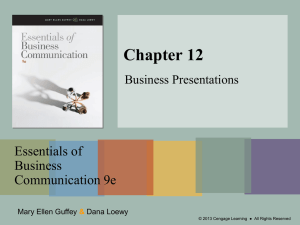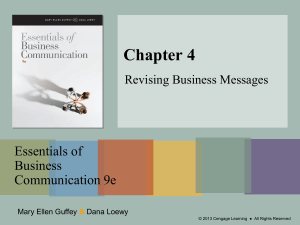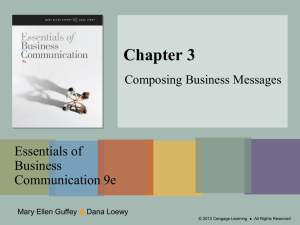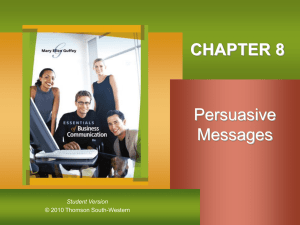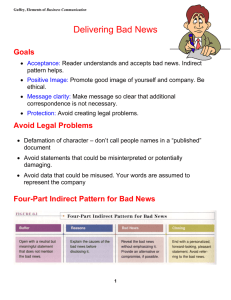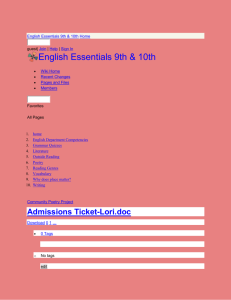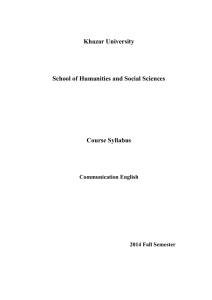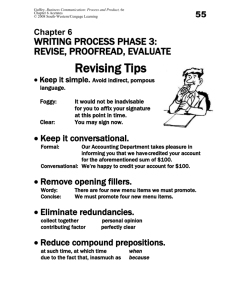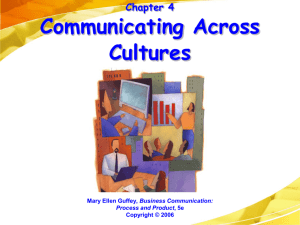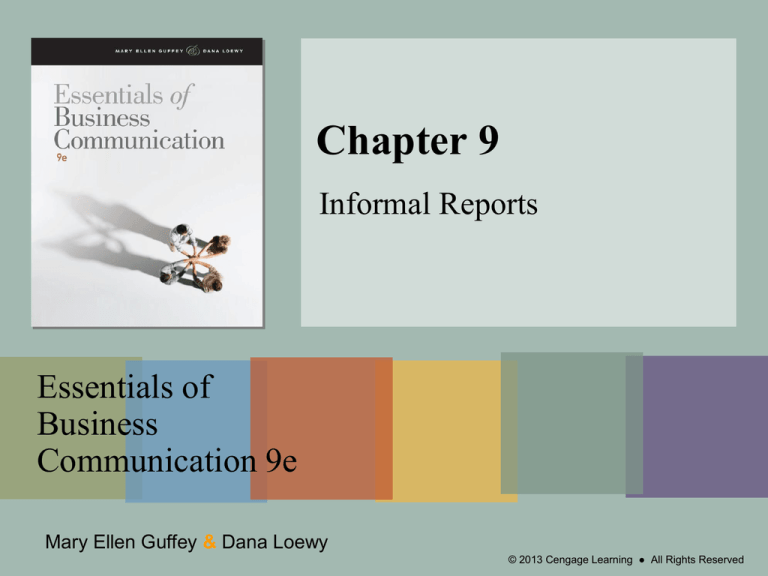
Chapter 9
Informal Reports
Essentials of
Business
Communication 9e
Mary Ellen Guffey & Dana Loewy
© 2013 Cengage Learning ● All Rights Reserved
Report Functions
© 2013 Cengage Learning ● All Rights Reserved
Informational
Present data without
analysis or
recommendations
Analytical
Present data or
findings, analyses,
conclusions, and
recommendations
Mary Ellen Guffey & Dana Loewy, Essentials of Business Communication, 9th Edition
Chapter 9, Slide 2
Report Patterns
The Direct Strategy
If readers
are informed
If readers
are supportive
If readers are
eager to have
results first
© 2013 Cengage Learning ● All Rights Reserved
Direct Strategy
Mary Ellen Guffey & Dana Loewy, Essentials of Business Communication, 9th Edition
Chapter 9, Slide 3
Direct Strategy
© 2013 Cengage Learning ● All Rights Reserved
Informational Report
Introduction/Background
Analytical Report
Introduction/Problem
Facts/Findings
_________________
__________________________________
CONCLUSIONS/
RECOMMENDATIONS
__________________________________
__________________________________
__________________________________
__________________________________
__________________________________
__________________________________
__________________________________
__________________________________
__________________________________
__________________________________
__________________________________
__________________________________
Summary
______________________
__________________________________
__________________________________
__________________________________
__________________________________
__________________________________
__________________________________
__________________________________
__________________________________
__________________________________
__________________________________
__________________________________
__________________________________
Facts/Findings
__________________________________
__________________________________
__________________________________
Discussion/Analysis
____________
__________________________________
__________________________________
__________________________________
Mary Ellen Guffey & Dana Loewy, Essentials of Business Communication, 9th Edition
Chapter 9, Slide 4
Report Patterns
The Indirect Strategy
If readers
need to be
educated
If readers need
to be persuaded
If readers may
be disappointed
or hostile
© 2013 Cengage Learning ● All Rights Reserved
Indirect Strategy
Mary Ellen Guffey & Dana Loewy, Essentials of Business Communication, 9th Edition
Chapter 9, Slide 5
Indirect Strategy
Analytical Report
Introduction/Problem
© 2013 Cengage Learning ● All Rights Reserved
__________________________________
__________________________________
__________________________________
__________________________________
Facts/Findings
_________________
__________________________________
__________________________________
__________________________________
Discussion/Analysis
__________________________________
__________________________________
__________________________________
CONCLUSIONS/
RECOMMENDATIONS____________
__________________________________
__________________________________
__________________________________
Mary Ellen Guffey & Dana Loewy, Essentials of Business Communication, 9th Edition
Chapter 9, Slide 6
Report Formats
Letter
For informal reports sent to outsiders
For informal reports sent within
Memo/E-Mail
organizations
© 2013 Cengage Learning ● All Rights Reserved
Manuscript
For longer, more formal reports.
Preprinted
forms
For routine activities, such as expense
reports.
Digital
Useful for collaboration and for posting
online
Mary Ellen Guffey & Dana Loewy, Essentials of Business Communication, 9th Edition
Chapter 9, Slide 7
Developing Informal Reports
© 2013 Cengage Learning ● All Rights Reserved
Determine problem
and purpose.
Gather data.
Organize data.
Write first draft.
Edit and revise.
Mary Ellen Guffey & Dana Loewy, Essentials of Business Communication, 9th Edition
Chapter 9, Slide 8
Gathering Data for Reports
© 2013 Cengage Learning ● All Rights Reserved
Company records
Printed materials (books, newspapers,
and periodicals)
Electronic resources (Web, electronic
databases, online resources)
Personal observation and
experience
Surveys, questionnaires,
and inventories
Interviews
Mary Ellen Guffey & Dana Loewy, Essentials of Business Communication, 9th Edition
Chapter 9, Slide 9
Typical Informal Reports
© 2013 Cengage Learning ● All Rights Reserved
Information reports
Progress reports
Justification/recommendation
reports
Feasibility reports
Minutes of meetings
Summaries
Mary Ellen Guffey & Dana Loewy, Essentials of Business Communication, 9th Edition
Chapter 9, Slide 10
Information Reports
What do they do?
© 2013 Cengage Learning ● All Rights Reserved
• Collect and organize information
• Provide findings without analysis
or persuasion
Mary Ellen Guffey & Dana Loewy, Essentials of Business Communication, 9th Edition
Chapter 9, Slide 11
Progress Reports
What do they do?
© 2013 Cengage Learning ● All Rights Reserved
• Explain the progress of continuing
projects
• May be internal or external
Mary Ellen Guffey & Dana Loewy, Essentials of Business Communication, 9th Edition
Chapter 9, Slide 12
Justification/Recommendation
Reports
What do they do?
© 2013 Cengage Learning ● All Rights Reserved
Justify or recommend something
(buying equipment, changing a
procedure, hiring an employee, etc.)
Mary Ellen Guffey & Dana Loewy, Essentials of Business Communication, 9th Edition
Chapter 9, Slide 13
Feasibility Reports
What do they do?
© 2013 Cengage Learning ● All Rights Reserved
• Examine the practicality and
advisability of a course of action
• Ask: Will this plan or proposal work?
Mary Ellen Guffey & Dana Loewy, Essentials of Business Communication, 9th Edition
Chapter 9, Slide 14
Informal Report Writing Style
© 2013 Cengage Learning ● All Rights Reserved
Uses
Characteristics
Short, routine reports
aimed at familiar
audiences
Noncontroversial reports
Most reports to company
insiders
Effect
Feeling of warmth, personal
involvement, closeness
Use of first-person pronouns (I,
we, us)
Use of contractions (can’t,
don’t, I’ll)
Emphasis on active-voice
verbs (I conducted the study)
Shorter sentences, familiar
words
Occasional use of humor,
metaphors
Acceptance of author’s
opinions, ideas
Mary Ellen Guffey & Dana Loewy, Essentials of Business Communication, 9th Edition
Chapter 9, Slide 15
Formal Report Writing Style
Uses
Characteristics
© 2013 Cengage Learning ● All Rights Reserved
Theses
Absence of first-person
pronouns; use of third person
Research studies
(the researcher, the writer)
Controversial and complex
Absence of contractions
reports, especially to
(cannot, do not)
outsiders
Use of passive-voice verbs (the
study was conducted)
Effect
Complex sentences, long
Impression of objectivity,
words
accuracy, professionalism,
Absence of humor, colorful
fairness
adjectives, adverbs
Distance created between
Elimination of author’s
writer and reader
“editorializing”
Mary Ellen Guffey & Dana Loewy, Essentials of Business Communication, 9th Edition
Chapter 9, Slide 16
Being Objective in Writing Reports
© 2013 Cengage Learning ● All Rights Reserved
Present both sides of
an issue.
Separate fact from
opinion.
Be sensitive and
moderate in language.
Cite sources carefully.
Mary Ellen Guffey & Dana Loewy, Essentials of Business Communication, 9th Edition
Chapter 9, Slide 17
Report Headings
Benefits
© 2013 Cengage Learning ● All Rights Reserved
Serve as an outline of the report
Highlight major ideas and categories
Act as guides for locating information
Provide resting points for the
mind and the eye
Organize data into meaningful
blocks
Mary Ellen Guffey & Dana Loewy, Essentials of Business Communication, 9th Edition
Chapter 9, Slide 18
Report Headings
Functional headings
describe functions or general topics
Background, Findings, Benefits, Costs
© 2013 Cengage Learning ● All Rights Reserved
Talking headings
describe content and provide more information
Benefits of Offering a Wellness Program
Mary Ellen Guffey & Dana Loewy, Essentials of Business Communication, 9th Edition
Chapter 9, Slide 19
Effective Report Headings
© 2013 Cengage Learning ● All Rights Reserved
Use appropriate heading levels.
Strive for parallel construction within levels.
Use first- and second-level headings for
short reports.
Capitalize and underline carefully.
Keep headings short but clear.
Include at least one heading per report page.
Mary Ellen Guffey & Dana Loewy, Essentials of Business Communication, 9th Edition
Chapter 9, Slide 20
END
Essentials of
Business
Communication 9e
Mary Ellen Guffey & Dana Loewy
© 2013 Cengage Learning ● All Rights Reserved

